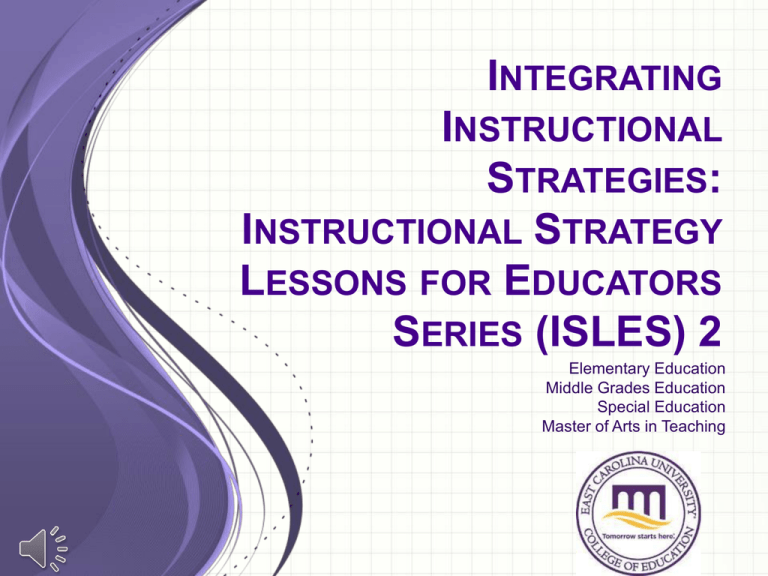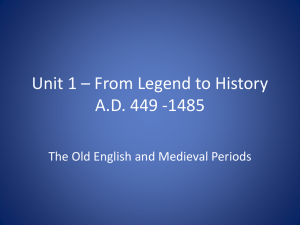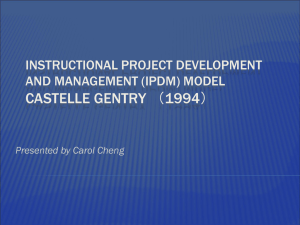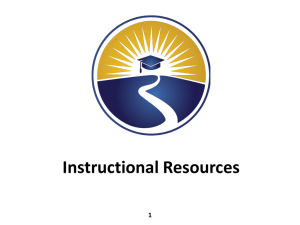Faculty Orientation for ISLES 2
advertisement

INTEGRATING INSTRUCTIONAL STRATEGIES: INSTRUCTIONAL STRATEGY LESSONS FOR EDUCATORS SERIES (ISLES) 2 Elementary Education Middle Grades Education Special Education Master of Arts in Teaching Learning Objectives By the end of this module you will be able to: • Identify instructions for the teacher candidate student • Explain the grading criteria • Identify the enhanced features • Use at least 4 of the instructional strategies during the teaching of the course using ISLES 2. New Faculty Orientation New Faculty Orientation: ISLES 2 • • • • • • • • Content of ISLES 2 Instructions Delivery platform Grading criteria and quiz Faculty role Clinical requirements Technology requirements Meeting educational needs: Essential understandings • Sample units New Faculty Orientation Content of ISLES 2 Instructional Strategy Lessons for Educators Series: Procedural Knowledge Level New Faculty Orientation Content of ISLES 1 Instructional Strategy Lessons for Educators Series: Declarative Knowledge Level = ISLES 1 • Online module with 5 categories (islands) • Each island contains definitions, key theorists, key research, benefits, and examples of the identified strategies. • Focus of ISLES 1 is declarative understanding of the strategies. New Faculty Orientation What is contained within this module? • Five lessons or islands each containing: – A review of the strategy definitions – An introduction to general and differentiated planning considerations when using the strategies – Lesson examples of the identified strategies – Video snippets of the strategies – Sample units incorporating the strategies New Faculty Orientation What does ISLES 2 include? The five islands represent the five categories of instructional strategies New Faculty Orientation Review: Strategies within the categories Organizers Concept Learning Question and Grouping Review Graphic organizers Examples/ Nonexamples Higher level questions that ask for explanations Think-Pair- Formative Share, assessment Advance organizers Compare and contrast Games Jigsaw New Faculty Orientation Assessment Summative assessment Samples from ISLES 2 modules New Faculty Orientation An advance organizer of organizers Graphic Organizers WHAT Visual teaching tools that deepen thinking skills and improve understanding of content. Advance Organizers WHAT Information that is presented prior to learning to orient the student to what will be taught. WHEN WHEN Can be used at any point during a lesson, as appropriate. Use when discussing prior knowledge part of the lesson and before presentation of new content. WHY WHY Engages students and organizes learning for retention and generalization of information by visual representations. Makes students aware of what will be happening in the lesson at all times and organizes the information. HOW There are many types of graphic organizers. HOW There are multiple types of advance organizers. Exploration In order to fully understand this island you need to complete the Concept Learning Island of the first I.S.L.E.S. Module or review the information within it. You can find the review here Concept Learning Review of Declarative Knowledge Level Module How to Select Strategies Before selecting a strategy the teacher must make several other decisions, e.g., what to teach, how to assess learning, etc. Click on this link to see a list of 10 considerations a teacher must make before selecting an appropriate instructional strategy: You may wish to print it for use during your lesson planning. Checklist for selecting instructional strategies Take A Look Step 1: Teacher poses a discussion topic or question Step 2: Students think individually from 10 seconds to 5 minutes: • What information is needed to solve the problem? • What do I already know? • What strategies and tools can I use? • What are some questions for my partner? Step 3: Talk about ideas with a partner for 2-3 minutes Step 4: Share ideas with large group for 3-4 minutes Think About – cont. Rewrite each lower level question below as a higher level question. Use the Instructional Rigor- Questions/Product Aligned with Revised Bloom’s Taxonomy as your guide. Keep this in your notes. Example: Who is your favorite character? Rewritten as a Higher Order Question: How is your favorite character most like you and most different from you? 1. What is a pentagon? 2. What is an example of a landform? 3. What would happen to vegetation in the event of an erupting volcano? 4. Demonstrate the order of the coins if they were grouped in value from least to greatest. 5. Can you list the names of the first five presidents? 6. How photosynthesis occur? 7. What is the purpose of the italicized word in the selection? 8. Describe the author’s perspective. Lesson Plan Think About Review the post-test of the TQP Science Unit on Forces and Motion at the link below. Then read the unit objectives and essential questions in the following screens. Are the objectives and essential questions aligned with the assessment? Provide evidence to support your answer. Select the link to read the middle grades post-test: MIDG Lesson To access the full version of the this TQP Model Unit and other sample units, click on the link below: http://www.coe3.ecu.edu/Isles/Procedural/Units/ Lesson Plan Think About Select the link to read a lesson from the TQP elementary language arts unit ELEM ELA Lesson • In what way did the teacher provide feedback to the student regarding the student’s understanding of the topic and performance? • What types of formative assessment strategies were used in this lesson? • Were the formative assessment strategies aligned with the lesson objectives? • Was enough time given so that students could complete formative assessment activities? Why do you think so? To access the full version of the this TQP Model Unit and other sample units, click on the link below: http://www.coe3.ecu.edu/Isles/Procedural/Units/ Instructions • Candidates • Faculty New Faculty Orientation ISLES 2 Student Instructions About ISLES What’s This? • Learn about a common framework for instructional practices that highlights ten evidence based strategies for increasing student achievement. • Explore the framework in your introduction courses, methods courses, senior courses, and internship. Understand it, explain it, see it, plan it, and do it! • Experience the connections with Pitt County and Greene County schools as their teachers incorporate a similar framework. New Faculty Orientation Take a Look TQP Instructional Practices Organizers Concept Learning Question and Review Grouping Assessment organizers Examples /Nonexamples Higher level questions that ask for explanations Think-Pair-Share Formative Advance Organizers Compare / Contrast Games Jigsaw Summative Graphic New Faculty Orientation • Complete an online series of Instructional Strategy Lessons for Educator Series (ISLES) modules focusing on the framework at every step. The islands within the modules are designed using the Star Legacy Framework. Hot Links • Dig more deeply into the Star Legacy Framework and why online modules were chosen. Click here: IRIS Center: http://iris.peabody.vanderbilt.edu/hpl/chalcycle.htm Think About • Consider how you will meet the needs of the diverse children in your classroom. The ISLES modules will prepare you to do just that, one semester at a time. New Faculty Orientation Instructional Strategy Lessons for Educators Series (ISLES) Overview Research has shown that student achievement is directly tied to teacher effectiveness. As a result, there is now a nationwide reform movement to improve teacher effectiveness. As part of the reform movement the Office of Innovation and Improvement in the United States Department of Education awarded “Teacher Quality Partnership Grants” to teacher education programs around the country. In the fall of 2009, the College of Education at East Carolina University won one of the 28 Grants. With the grant funds, ECU’s College of Education is reforming several areas of its program: Recruitment, Curriculum, and Clinical Practice. ECU partners, Pitt County Schools and Greene County Schools, are reforming their induction programs as well. New Faculty Orientation Overview – continued The ISLES Module that you are about to complete is part of the curriculum component of the reform. It is designed to teach you 10 particular instructional strategies. They are not the only strategies that are effective or that a prospective teacher should learn to incorporate in instruction. The 10 instructional strategies discussed in the module constitute a starting place; over time you are expected to learn additional effective instructional strategies. You will receive instruction on those additional strategies from your professors. Also note that instructional strategies are not the only means of raising student achievement. An effective teacher must have good classroom management, an effective curriculum, and appropriate professional dispositions. For now, however, the curriculum reform is focusing primarily on effective instructional strategies. New Faculty Orientation Overview – continued The goal of the declarative module (ISLES 1) was to teach you what the strategies are. This module (ISLES 2) is at the procedural knowledge level is designed to teach you how to incorporate the strategies into lesson plans. You will complete the module for implementing these strategies later in your program. The following instructions will help you complete the module successfully. Please read all of them carefully. Thank you for your cooperation and good luck in your quest to become an effective teacher. New Faculty Orientation Module Instructions Provided to the Students Please read all of the instruction carefully before accessing the online module. 1. The ISLES #2: Procedural Knowledge module is a required course assignment embedded in your Blackboard (BB) course. 2. It is important that you try your best when completing it and treat it as seriously as any other assignment in the course. 3. It is also imperative that you maintain the highest academic integrity while completing it. Please do not discuss the assessment questions or answers with anyone else until after everyone has completed it. 4. The module is comprised of 5 Islands (Organizers, Concept Learning, Question & Review, Grouping, and Assessment). Two strategies from each category are taught. 5. It should take you between 30 minutes and 1 hour to complete each of the 5 islands. 6. Carefully plan when and where you complete the module. Select a quiet comfortable location with enough time to complete a single island. 7. You should also take notes while completing the islands. New Faculty Orientation 8. The ISLES module will be located in your course Blackboard site. 9. Once you access the site, you will see five presentations, each one representing a different island of the module. 10. Begin with the Organizers island. Work through that presentation. If time permits, continue on to the Concept Learning island from there. If you don’t have time to do more than one island at a time, simply return to the website when you are able to do so. Follow this procedure for each of the remaining islands: Question & Review, Grouping, and Assessment. Be sure to complete the islands in order; this is important since the content of an island builds upon content in prior islands. New Faculty Orientation 11. Each island has the same 5-part structure: Mission, First Impressions, Exploration, Assessment, and Review. In the Mission section, you learn about a familiar problem or situation that teachers encounter in their classrooms. From there you move to First Impressions where your prior knowledge about the mission is activated. In the Exploration part of the lesson you learn the lesson objective and the information about the instructional strategies in that category. After exploring the topic, you will assess your understanding in the Assessment part of the lesson using a multiple-choice quiz. Finally, you will review what you learned in the Review section with references and resources. 12. When taking the quiz in the Assessment section of the lesson, you must answer each item to move forward and you cannot change your answer once it has been submitted. Blackboard will record your grade for each island and calculate your total grade for the module. 13. You are now ready to begin the ISLES #2 Module. If you need technical assistance, submit a request to http://coehelp.ecu.edu End of Student Instructions.. New Faculty Orientation The following guides are available as links from http://www.ecu.edu/educ/tqp • ISLES – FAQ Faculty Instructions • ISLES Faculty Guide New Faculty Orientation Delivery Platform New Faculty Orientation How is this module delivered to my class? ISLES 2 is available as a Blackboard Learning Module and will be distributed by the Blackboard administrator prior to the beginning of the semester. New Faculty Orientation Grading Criteria New Faculty Orientation How are candidates assessed in meeting the objectives of the module? • • • • Included in the ISLES 2 course syllabus Counts between 5%-10% of the overall course grade Candidates visit each of the 5 islands (categories) Candidates take a multiple choice question quiz in Blackboard for each island (total of five quizzes). • Grades are automatically computed in and recorded in the grade book in Blackboard. • Candidates return to ISLES 2 to complete the post-module review and references. New Faculty Orientation Faculty Role New Faculty Orientation What is my role in this course? • All ELEM, MIDG, and SPED faculty are strongly encouraged to review ISLES 2 to learn what the students are expected to learn and do. • Faculty members are responsible for requiring completion of ISLES 2 as a part of course requirements. • Faculty members are encouraged to utilize the eight sample units found in the module. – Created by teachers and ECU faculty – Incorporates Common Core and Essential Standards – Incorporates differentiation for English Language Learners, Academically and Intellectually Gifted, Universal Design for Learning, Literacy, and Technology. – Content briefs developed by College of Arts and Sciences faculty New Faculty Orientation Clinical Requirements New Faculty Orientation Do the candidates have clinical requirements? There are no clinical requirements associated with ISLES 2. New Faculty Orientation Technology Requirements New Faculty Orientation What technology is needed by the candidates? In addition to Internet access, candidates will need: • access to Blackboard to view the files and take the quizzes; • Adobe Acrobat Reader to view the PDF files • A program to view videos. New Faculty Orientation Enhanced Features New Faculty Orientation Enhanced Features • Addressing meeting the educational needs of all learners: – – – – – English Language Learners (ELL) Academically and Intellectually Gifted (AIG) Universal Design for Learning (UDL) Literacy Instructional Technology • Planning Considerations checklists to assist in utilizing the ISLES strategies • Sample units in different subject/grade levels highlighted. (Full units available at http://www.coe3.ecu.edu/Isles/Procedural/Units ) • New Faculty Orientation Strategies included in each Island Specific Types of Strategy Applications Identified In Each Island Organizers Concept Learning Question and Review Grouping Assessment Circle, bubble, joining bubbles or double bubbles, tree, flow chart, brace map, multiflow map Example/Non-Example, Compare/contrast Question sequencing, extending and lifting, circular path, same path Games Think-Pair-Share, jigsaw Three-minute conference, goal setting chart, growth conference, thumbs up/thumbs down, 3-2-1, Head, Heart, and Foot, rubrics, descriptive and evaluative feedback, explicit feedback New Faculty Orientation Planning Considerations for the Use of Organizers with Diverse Learners Links to what you need to know now.* • • • • • Academically and Intellectually Gifted (AIG) Planning Checklist English Language Learners (ELL) Planning Checklist Instructional Technology (IT) Planning Checklist Literacy (LIT) Planning Checklist Universal Design for Learning (UDL) Planning Checklist * Most students find it helpful to print these documents for use when planning lessons. . Summary • Elementary education, middle grades education, special education, and the Master of Arts in Education programs are incorporating the teaching and modeling of instructional strategies. • ISLES 2 is the procedural knowledge level module. • ISLES 2 modules include sample units incorporating each instructional strategy. New Faculty Orientation Resources • ISLES Faculty Guide http://www.ecu.edu/cseduc/TQP/upload/ISLESfacultyGUIDE2013-14.pdf • TQP website http://www.ecu.edu/educ/tqp • Public version of ISLES 2 http://www.coe3.ecu.edu/Isles/Procedural New Faculty Orientation Resources - continued • Elementary Education http://www.ecu.edu/educ/emge/elem/ • Middle Grades Education http://www.ecu.edu/educ/emge/midg/ • Special Education http://www.ecu.edu/educ/sefr/sped/ • Professional Development Series for ISLES New Faculty Orientation THIS CONCLUDES THIS MODULE ON THE ISLES 2 New Faculty Orientation









